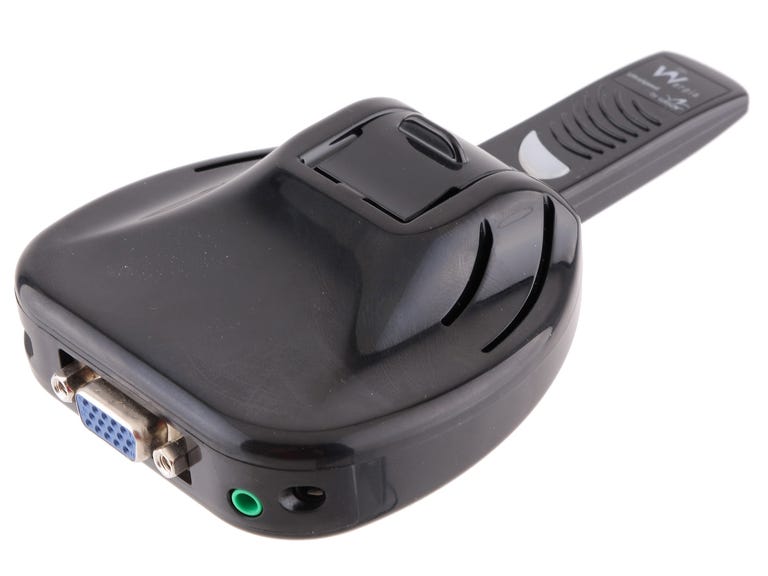 Why You Can Trust CNET
Why You Can Trust CNET Warpia Wireless USB PC to TV review: Warpia Wireless USB PC to TV
Warpia Wireless USB PC to TV
It seems that every PC laptop these days offers a convenient HDMI-out port that connects directly to an HDTV, allowing you to transform a big screen into an additional monitor. For those with laptops missing that vital HDMI slot, especially anyone with an Apple laptop, there aren't too many options in accomplishing the same end result.
The Good
The Bad
The Bottom Line
Last year we looked at the IOGear Wireless Audio/Video Kit, which was a bit expensive and kind of a pain to set up. Regardless, once up and running, it did exactly what it was supposed to. We wish it came with some sort of HDMI support, the absence of which severely hindered our decision to recommend the product.
With the Warpia USB-to-TV system, we've found a similar product with an overall better design and improved functionality. If your laptop isn't equipped with an HDMI port, this system is worth checking out if you want to get audio and video from a laptop to your HDTV.
The Warpia system consists of two main devices, a USB transmitter and a USB AV receiver. The receiver also has a detachable USB dongle that can be positioned in one of two orientations. The unit can also be wall-mounted, though keep in mind it still must be close enough to attach to an HDTV or receiver.

The USB transmitter is a right-angled dongle that can rotate 270 degrees for optimal reception. It's no bigger than a standard-size thumbdrive and has a green LED light that blinks during operation. The receiving base offers a standard VGA port, HDMI-out, and 1/8-inch audio port. The base also requires power from the included AC adapter.
We were surprised at how simple setup was. Though the system comes with an installation CD, the company's Web site has the most updated drivers for the included devices. Both the transmitter and receiver operate on separate firmware, so you'll garner the best performance results with the latest versions of each.
During software and driver installation, the application will ask for the transmitter to be plugged in, followed by the receiver. Once both are updated and confirmed, the installed Wireless USB Manager takes care of everything else.
There's a certain comfort in the plug-and-play convenience the Warpia provides, as each time we plugged the transmitter dongle in, the signal instantly jumped over to our receiver and the HDTV it was tethered to.
We did have a slight issue with our laptop screen automatically adjusting its own resolution, but it was nothing a quick display setting change couldn't fix. When connected, the Warpia system allows you either mirror or extend your current screen to an HDTV. All of these settings are easily accessible via the system tray icon that's installed during the initial one-time setup.
Performance-wise, we were extremely happy with the results of wirelessly transmitting our laptop's screen. Our Panasonic HDTV had no issues accepting the 1,280x960-pixel signal using the HDMI-out on the receiving base.
For an even higher resolution, there's the option to use the SXVGA+ port that can support up to 1,400x1,050 pixels. Keep in mind, though, that not all HDTVs accept this type of interface connection, so odds are that HDMI will be the way to go. Warpia says the system can support up to 720p HD streaming video; anything higher will drop frames and lag as our testing confirmed.
As for mouse-to-screen time, there is a tiny bit of a noticeable lag, so we can't recommend using the system for gaming or any application where real-time movement is a must.
The Warpia system is also a bit sensitive when it comes to blocking line of sight between the transmitter and receiver. We noticed a bit of a signal drop when placing multiple obstructions in between the two, but for normal use we don't think it will be too much of an issue. That said, don't expect the Warpia to work through walls and floors, as there needs to be very little in between the two devices. The Warpia performed well in our 25x25-foot testing room, but it struggled the second we left it.
In terms of audio, we had no problem using the audio over HDMI and the separate 1/8-inch jack on the rear of the receiver. Furthermore, we didn't notice a difference in quality regardless of which interface we used.
Though the company does not advertise the PC-to-TV system as being able to do so, there is some hope for Mac users out there. Using a few beta drivers and software hosted on the company's site, we were successfully able to wirelessly stream our MacBook Pro to our HDTV. Keep in mind that this is not officially supported by Warpia, so any issues with using the technology may not be easily resolved. Regardless, we're happy to see the Mac support here.
Our only qualm with Mac performance was full-screen video. It seems the system has an easier time streaming full-screen video from a PC than it does with a Mac. We had some success with dragging a video player to take up the entire screen, but once in full-screen mode, the video began to get choppy.
Overall, we were impressed with the Warpia system. For around $160, it's certainly not cheaper than running a few wires directly to your HDTV, but for those in need of such a wireless luxury, we're not sure there's an easier way to get audio and video from your laptop to your big screen.


